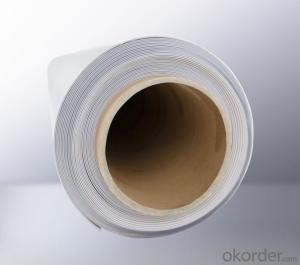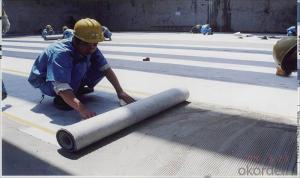Thermoplastic Polyolefins Waterproofing Membrane
- Loading Port:
- China main port
- Payment Terms:
- TT OR LC
- Min Order Qty:
- 5000 m²
- Supply Capability:
- 100000 m²/month
OKorder Service Pledge
OKorder Financial Service
You Might Also Like
1.Structure of TPO Waterproofing Membrane Description:
TPO waterproofing membrane is the thermoplastic polyolefins waterproofing materials, with advanced polymerization technology of combing ethylene-propylene rubber and polypropylene thermoplastic polyolefin (TPO) synthetic resin as basic material.And adding antioxidants, new waterproofing materials made of protective agent, softener, the product can do internal enhancement with polyester fiber mesh cloth material enhanced waterproofing materials.It is a synthetic polymer waterproof coiled material waterproof products.This product is suitable for building the leakage or non exposed roofing waterproof layer, building underground waterproof for easy deformation.Especially in light steel structure roofing, with rational design and qualified construction quality level, it xan reduce the roof weight, and alao has good energy saving effect.Besides,it also can do waterproof and condensation,that is a large industrial buildings and public buildings roofing waterproof material of choice.
2.Main Features of TPO Wateproofing Membrane:
•Good weather resistance
•Good Flexibility
•Strong aging resistance
•High tensile strength,high elongation
•Good fatigue resistance and puncture resistance
•Convenient for construction
3.TPO Wateproofing Membrane Specification:
| Name | Width | Length | Thickness | |
TPO Wateproofing Membrane | 2m | 20m | 1.2mm | |
| 2.05m | 30.5m | 1.5mm | ||
| 3.05m | 1.8mm | |||
| 2.0mm |

- Q: Can a waterproofing membrane be used in elevator pits?
- Yes, a waterproofing membrane can be used in elevator pits. Elevator pits are vulnerable to water damage and moisture accumulation, so applying a waterproofing membrane can help prevent water intrusion and protect the elevator components from potential damage.
- Q: Can waterproofing membranes be used on roofs with slopes?
- Yes, waterproofing membranes can be used on roofs with slopes. These membranes are designed to provide a protective barrier against water infiltration and are commonly used on roofs with varying degrees of slope to prevent leaks and water damage.
- Q: Can a waterproofing membrane be used on roofs with standing water or ponding?
- No, a waterproofing membrane should not be used on roofs with standing water or ponding. While waterproofing membranes are designed to provide a protective barrier against water penetration, they are not meant to be submerged or exposed to constant water accumulation. Standing water or ponding on a roof can cause a variety of issues, such as increased weight load, potential structural damage, and increased risk of leaks. It is important to address any drainage issues and ensure proper roof slope to prevent standing water before considering the application of a waterproofing membrane.
- Q: Can a waterproofing membrane be used on modified bitumen roofs?
- Yes, a waterproofing membrane can be used on modified bitumen roofs. In fact, it is a common practice to install a waterproofing membrane over modified bitumen roofs to provide an additional layer of protection against water infiltration. This is especially important in areas with heavy rainfall or where the roof is prone to frequent exposure to water. The waterproofing membrane helps to seal any potential cracks or gaps in the modified bitumen roofing system, preventing water from seeping through and causing damage to the underlying structure. Additionally, the waterproofing membrane can also enhance the overall durability and longevity of the roof by protecting it from the harmful effects of moisture.
- Q: Is the waterproofing membrane an insulating material?
- Insulation board: plastic plate is made of plastic sheet, plastic for the synthesis of polymer compounds, can be free to change the body style. Plastic is the use of monomer raw materials to synthesis or condensation reaction polymerization of materials, synthetic resin and filler, plasticizers, stabilizers, lubricants, colorants and other additives, and its main component is synthetic resin.
- Q: Can a waterproofing membrane be used on tunnels with seismic protection systems?
- Yes, a waterproofing membrane can be used on tunnels with seismic protection systems. In fact, it is highly recommended to use a waterproofing membrane in such tunnels to prevent water ingress and subsequent damage to the structure. Seismic protection systems are designed to absorb and dissipate the energy generated by an earthquake, ensuring the safety and stability of the tunnel. However, these systems do not provide any protection against water infiltration. By installing a waterproofing membrane, the tunnel can be safeguarded against potential water leaks and seepage, which can lead to corrosion of reinforcement, deterioration of concrete, and overall structural damage. It is important to select a waterproofing membrane specifically designed for use in tunnels, considering factors such as flexibility, durability, and resistance to movement caused by seismic events. Additionally, proper detailing and installation techniques should be employed to ensure a seamless and effective waterproofing system that works in conjunction with the tunnel's seismic protection measures.
- Q: How does a waterproofing membrane handle joint movement?
- To prevent water infiltration and maintain its effectiveness, a waterproofing membrane is specially crafted to handle joint movement. It accomplishes this by exhibiting flexibility and the ability to adapt to the expansion and contraction of joints. When joints experience movement due to factors like temperature fluctuations or settling of the structure, a waterproofing membrane must have the capability to stretch and compress without tearing or compromising its waterproofing properties. This is typically achieved through the utilization of elastomeric materials, such as rubber or synthetic polymers, which boast exceptional elongation and recovery properties. Moreover, waterproofing membranes may incorporate reinforcing materials, such as fabric or mesh, to enhance their tensile strength and their capacity to withstand joint movement. These reinforcements assist in distributing the stresses caused by joint movement, thus preventing localized damage and preserving the integrity of the membrane. Furthermore, certain waterproofing membranes possess special adhesive properties that enable them to tightly bond to the surfaces they are applied to, including the edges of joints. This adhesive bond plays a crucial role in establishing a continuous barrier against water penetration, even in the presence of joint movement. In summary, a waterproofing membrane is designed to exhibit flexibility and durability, ensuring effective management of joint movement, long-term protection against water intrusion, and the preservation of the structural integrity of the building or structure.
- Q: Can a waterproofing membrane be used for swimming pool coping?
- Using different grammar and expressions: Using a waterproofing membrane for swimming pool coping is not possible. Coping is the term used for the material that covers the upper edges of the pool walls, usually made of concrete, stone, or tile. Its main purposes are to provide a polished appearance and shield the pool structure from water damage. Conversely, a waterproofing membrane is a substance applied to a structure's surface, such as a basement or roof, to prevent water infiltration. Although both serve the same purpose of water protection, they are specifically designed for distinct applications and cannot be interchanged.
- Q: What is the accounting subject of the waterproofing membrane
- For external construction, included in the construction Self-service maintenance, included in the manufacturing costs (management costs)
- Q: Can a waterproofing membrane be used for roofing applications?
- Indeed, a waterproofing membrane can be utilized in roofing applications. Specifically designed to create a barrier against water infiltration, waterproofing membranes are commonly employed in a range of construction projects, including roofs. These membranes typically consist of durable materials like synthetic rubber, thermoplastics, or modified bitumen, renowned for their water-resistant properties and longevity. By installing a waterproofing membrane on the roof, one can effectively safeguard the building from water leaks and moisture penetration, which may result in structural damage, mold growth, and other related problems. The membrane is typically applied seamlessly onto the roof surface, forming a watertight layer that prevents water from permeating through. Waterproofing membranes for roofing applications are available in various types, such as sheet membranes, liquid or spray-applied membranes, or self-adhering membranes. Each type offers distinct advantages and suitability depending on the specific roofing requirements and construction conditions. In conclusion, a waterproofing membrane is indeed a viable choice for roofing applications, providing an efficient solution to ensure a durable and watertight roof system.
Send your message to us
Thermoplastic Polyolefins Waterproofing Membrane
- Loading Port:
- China main port
- Payment Terms:
- TT OR LC
- Min Order Qty:
- 5000 m²
- Supply Capability:
- 100000 m²/month
OKorder Service Pledge
OKorder Financial Service
Similar products
Hot products
Hot Searches
Related keywords


























